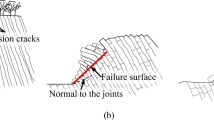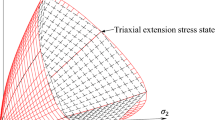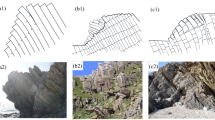Abstract
Block-flexure toppling is the commonest type of failure in anti-dip bedding rock slopes. In this work, a new model called the force-transfer model (FTM) for this kind of failure is proposed, which is based on cantilever beams and limit equilibrium theory. A genetic algorithm (GA) was further employed to predict the safety factor and failure surface of the rock slope. A centrifuge test was also conducted to check the feasibility of using the combined FTM–GA method to model block-flexure toppling failure. The centrifugal results showed that a complex failure surface was produced in a slope undergoing block-flexure toppling. The failure surface is stepped and has a step height approximately equal to the spacing of the cross joints. Comparing these results with the theoretical ones shows that it is eminently feasible to use the FTM–GA method to analyze the stability of slopes liable to undergo block-flexure toppling failure. Moreover, the safety factor (i.e., failure load in the centrifugal test) and failure surface of the slope can be accurately determined using the new method. The newly proposed method can, therefore, be used as a theoretical tool for evaluating and designing anti-dip bedding rock slopes.














Similar content being viewed by others
Abbreviations
- H :
-
Height of the slope
- \( \beta_{\text{s}} \) :
-
Angle of the slope
- \( \beta_{\text{c}} \) :
-
Angle of the set of cross joints
- \( t_{\text{c}} \) :
-
Spacing of the cross joints
- \( t_{\text{d}} \) :
-
Spacing of the joints dipping steeply into the slope face
- \( i \) :
-
Number of continuous or discrete rock layers, both numbered from the crest to the toe of the slope
- \( P_{{{\text{c}},i}}^{l} \) :
-
Normal force acting on the left-hand side of the continuous rock layer under consideration
- \( Q_{{{\text{c}},i}}^{l} \) :
-
Shear force acting on the left-hand side of the continuous rock layer under consideration
- \( P_{{{\text{c}},i}}^{r} \) :
-
Normal force acting on the right-hand side of the continuous rock layer under consideration
- \( Q_{{{\text{c}},i}}^{r} \) :
-
Shear force acting on the right-hand side of the continuous rock layer under consideration
- \( w_{{{\text{c}},i}} \) :
-
Weight of the continuous rock layer under consideration
- \( h_{{{\text{c}},i}} \) :
-
Height of the continuous rock layer under consideration
- \( c_{\text{d}} \) :
-
Cohesion of the set of joints dipping steeply into the face
- \( \varphi_{\text{d}} \) :
-
Friction angle of the set of joints dipping steeply into the face
- \( l_{i} \) :
-
Height of left-hand side of the continuous rock layer under consideration
- \( r_{i} \) :
-
Height of right-hand side of the continuous rock layer under consideration
- \( \chi \) :
-
Dimensionless parameter related to the distribution of normal stresses
- \( P_{{{\text{d}},i}}^{l} \) :
-
Normal force on the left-hand side of the discrete rock layer under consideration
- \( P_{{{\text{d}},i}}^{r} \) :
-
Normal force on the right-hand side of the discrete rock layer under consideration
- \( w_{{{\text{d}},i}} \) :
-
Weight of the discrete rock layer under consideration
- \( P_{{{\text{c}},i,t}}^{l} \) :
-
Normal force acting on the left-hand side of the continuous rock layer that enables it to be in the equilibrium state of flexural toppling
- \( N_{{{\text{c}},i}} \) :
-
Normal force acting on the base of the continuous rock layer under consideration
- \( S_{{{\text{c}},i}} \) :
-
Shear force acting on the base of the continuous rock layer under consideration
- \( M_{{{\text{c}},i}} \) :
-
Moment acting on the base of the continuous rock layer under consideration
- \( \sigma_{{{\text{c}},i,t}}^{\hbox{max} } \) :
-
Maximum tensile stress on the base of the continuous rock layer under consideration
- \( I \) :
-
Inertia of the continuous rock layers (given by \( I = t_{\text{d}}^{3} /12 \))
- \( F_{\text{s}} \) :
-
Safety factor of the slope
- \( c \) :
-
Cohesion of the intact rock
- \( \varphi \) :
-
Friction angle of the intact rock
- \( \sigma_{\text{t}} \) :
-
Tensile strength of the intact rock
- γ :
-
Unit weight of the intact rock
- \( P_{{{\text{c}},i,{\text{s}}}}^{l} \) :
-
Normal force acting on the left-hand side of the continuous rock layer that enables it to be in the equilibrium state of shearing
- \( h_{i,\hbox{max} } \) :
-
Maximum height of a rock layer
References
Adhikary DP, Dyskin AV (2007) Modelling of progressive and instantaneous failures of foliated rock slopes. Rock Mech Rock Eng 40(4):349–362
Adhikary DP, Dyskin AV, Jewell RJ, Stewart DP (1997) A study of the mechanism of flexural toppling failure of rock slopes. Rock Mech Rock Eng 30(2):75–93
Alejano LR, Alonso E (2005) Application of the ‘shear and tensile strength reduction technique’ to obtain factors of safety of toppling and footwall rock slopes. In: Impact of human activity on the geological environment—proceedings of the international symposium of the international society for rock mechanics, Eurock 2005, pp 7–13
Alejano LR, Gómez-Márquez I, Martínez-Alegría R (2010) Analysis of a complex toppling-circular slope failure. Eng Geol 114(1–2):93–104
Alejano LR, Carranza-Torres C, Giani GP, Arzúa J (2015) Study of the stability against toppling of rock blocks with rounded edges based on analytical and experimental approaches. Eng Geol 195:172–184
Alejano LR, Sánchez-Alonso C, Pérez-Rey I, Arzúa J, Alonso E, González J (2018) Block toppling stability in the case of rock blocks with rounded edges. Eng Geol 234:192–203
Alzo’ubi AK, Martin CD, Cruden DM (2010) Influence of tensile strength on toppling failure in centrifuge tests. Int J Rock Mech Min Sci 47(6):974–982
Amini M, Majdi A, Aydan Ö (2009) Stability analysis and the stabilisation of flexural toppling failure. Rock Mech Rock Eng 42(5):751–782
Amini M, Majdi A, Veshadi MA (2012) Stability analysis of rock slopes against block-flexure toppling failure. Rock Mech Rock Eng 45(4):519–532
Aydan AP, Kawamoto T (1992) The stability of slopes and underground openings against flexural-toppling and their stabilisation. Rock Mech Rock Eng 25:143–165
Bhandary RP, Krishnamoorthy A, Rao AU (2019) Stability analysis of slopes using finite element method and genetic algorithm. Geotech Geol Eng 37:1877–1889
Bobet A (1999) Analytical solutions for toppling failure. Int J Rock Mech Min Sci 36:971–980
Goldberg DE (1989) Genetic algorithms in search, optimization and machine learning. Addison-Wesley, Reading
Goldberg DE, Holland JH (1988) Genetic algorithms and machine learning. MLear 3(2–3):95–99
Goodman RE, Bray JW (1976) Toppling of rock slopes. In: Rock engineering for foundations & slopes. ASCE, pp 201–234
Gu D, Huang D (2016) A complex rock topple-rock slide failure of an anticlinal rock slope in the wu gorge, yangtze river, China. Eng Geol 208:165–180
Holland JH (1975) Adaptation in natural and artificial systems. Q Rev Biol 6(2):126–137
Huang D, Gu DM (2017) Influence of filling-drawdown cycles of the Three Gorges reservoir on deformation and failure behaviors of anticlinal rock slopes in the Wu Gorge. Geomorphology 295:489–506
Huang RQ, Li WL (2011) Formation, distribution and risk control of landslides in China. J Rock Mech Geotech Eng 3(2):97–116
Jurado-Piña R, Jimenez R (2014) A genetic algorithm for slope stability analyses with concave slip surfaces using custom operators. Eng Optim 47:1–20
Lian JJ, Li Q, Deng XF, Zhao GF, Chen ZY (2018) A numerical study on toppling failure of a jointed rock slope by using the distinct lattice spring model. Rock Mech Rock Eng 51(2):513–530
Liu CH, Jaksa MB, Meyers AG (2008) Improved analytical solution for toppling stability analysis of rock slopes. Int J Rock Mech Min Sci 45(8):1361–1372
Liu CH, Jaksa MB, Meyers AG (2009) A transfer coefficient method for rock slope toppling. Can Geotech J 46(1):1–9
Liu CH, Jaksa MB, Meyers AG (2010) Toppling mechanisms of rock slopes considering stabilization from the underlying rock mass. Int J Rock Mech Min Sci 46:348–354
Manouchehrian A, Gholamnejad J, Sharifzadeh M (2014) Development of a model for analysis of slope stability for circular mode failure using genetic algorithm. Environ Earth Sci 71:1267–1277
Mitchell M (1996) An introduction to genetic algorithms. MIT, Cambridge
Mohtarami E, Jafari A, Amini M (2014) Stability analysis of slopes against combined circular–toppling failure. Int J Rock Mech Min Sci 67(2):43–56
Sagaseta C, Sanchez JM, Canizal J (2001) A general analytical solution for the required anchor force in rock slopes with toppling failure. Int J Rock Mech Min Sci 38(3):421–435
Sarma SK, Tan D (2006) Determination of critical slip surface in slope analysis. Geotechnique 56(8):539–550
Zeng P, Jimenez R, Jurado-Pina R (2015) System reliability analysis of layered soil slopes using fully specified slip surfaces and genetic algorithms. Eng Geol 193:106–117
Zhang GC, Wang F, Zhang H, Tang HM, Li XH, Zhong Y (2018) New stability calculation method for rock slopes subject to flexural toppling failure. Int J Rock Mech Min Sci 106:319–328
Zheng Y, Chen C, Liu TT, Xia KZ, Liu XM (2018a) Stability analysis of rock slopes against sliding or flexural-toppling failure. Bull Eng Geol Environ 77:1383–1403
Zheng Y, Chen CX, Liu TT, Zhang HN, Xia KZ, Liu F (2018b) Study on the mechanisms of flexural toppling failure in anti-inclined rock slopes using numerical and limit equilibrium models. Eng Geol 237:116–128
Zheng Y, Chen CX, Liu TT, Song DR, Meng F (2019) Stability analysis of anti-dip bedding rock slopes locally reinforced by rock bolts. Eng Geol 251:228–240
Acknowledgements
The research was financially supported by National Natural Science Foundation of China (Grant nos. 11602284 and 11472293), Natural Science Foundation of Hubei province, China (Grant no. 2018CFB450), and the Open Research Fund of the State Key Laboratory of Geomechanics and Geotechnical Engineering, Institute of Rock and Soil Mechanics, Chinese Academy of Sciences (Grant no. Z018009).
Author information
Authors and Affiliations
Corresponding authors
Ethics declarations
Conflict of interest
The authors declare that there are no conflicts with this publication.
Additional information
Publisher's Note
Springer Nature remains neutral with regard to jurisdictional claims in published maps and institutional affiliations.
Rights and permissions
About this article
Cite this article
Zheng, Y., Chen, C., Meng, F. et al. Assessing the Stability of Rock Slopes with Respect to Block-Flexure Toppling Failure Using a Force-Transfer Model and Genetic Algorithm. Rock Mech Rock Eng 53, 3433–3445 (2020). https://doi.org/10.1007/s00603-020-02122-2
Received:
Accepted:
Published:
Issue Date:
DOI: https://doi.org/10.1007/s00603-020-02122-2




